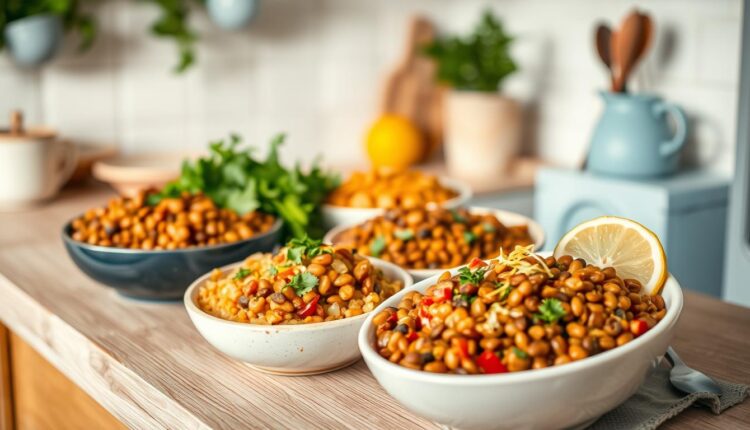High Protein Lunch Prep Lentils With Global Flavors
Simplify meal prep with our top high protein lunch prep lentils recipes. Global flavors, easy prep, and healthy eating for busy lives.
What if your weekly meals could be both nourishing and adventurous? These tiny legumes pack a punch with plant-based protein and fiber, making them ideal for creating satisfying dishes that fuel busy days. Whether you’re juggling back-to-back meetings or after-school activities, this guide offers a fresh take on meal planning—one that embraces bold spices, vibrant textures, and smart prep strategies.
As a chef and mom of two, I’ve learned that meal planning thrives on simplicity. My kitchen experiments—from smoky Spanish-inspired stews to zesty Thai curry bowls—prove humble ingredients can become extraordinary. Explore dishes like marinated lentil salads or coconut curry bowls that freeze beautifully, paired with practical tips for balancing flavor and efficiency.
Meal prep magic starts here:
• Transform pantry staples into globally inspired lunches in under 90 minutes
• Discover freezer-friendly techniques from my balanced lunch strategies
Introduction: Embracing Global Flavors in Lentil Meals
Imagine your lunchbox becoming a passport to vibrant flavors. As a chef and mom, I’ve discovered that these tiny legumes—often overlooked—hold the key to meals that feel both comforting and exciting. Whether simmered into a Moroccan harira or tossed with lemon and oregano for a Greek twist, they adapt effortlessly to global pantry staples.
Why Lentils Belong in Your Kitchen
Lentils are more than just budget-friendly—they’re a nutrition trifecta. A single cup delivers 18 grams of plant-based protein and 15 grams of fiber, keeping you full longer while supporting muscle recovery. “They’re my secret weapon for busy weeks,” I tell my cooking class students. From French green to split red varieties, each type offers unique textures perfect for soups, salads, or even tacos.
Spice Routes Made Simple
You don’t need a plane ticket to explore world cuisines. A sprinkle of cumin transforms basic lentils into a smoky Mexican-inspired base, while harissa paste adds North African heat. My family’s favorite? A quick coconut curry simmer with turmeric and ginger—ready in 30 minutes and freezer-friendly for grab-and-go lunches.
Meal prep becomes an adventure when you view spices as flavor heroes. Start with one global technique this week—maybe a Turkish-inspired tomato sauce or Indian masala blend—and watch humble ingredients become crave-worthy dishes.
Nutritional Power: Why Lentils Are Your Protein Source of Choice
What makes these tiny legumes a staple in athlete meal plans and family kitchens alike? Beyond their budget-friendly reputation, they deliver a powerhouse combo of nutrients that keep energy levels steady and bodies strong. One cooked cup packs over 17 grams of protein—nearly matching three eggs—plus a third of your daily fiber needs.
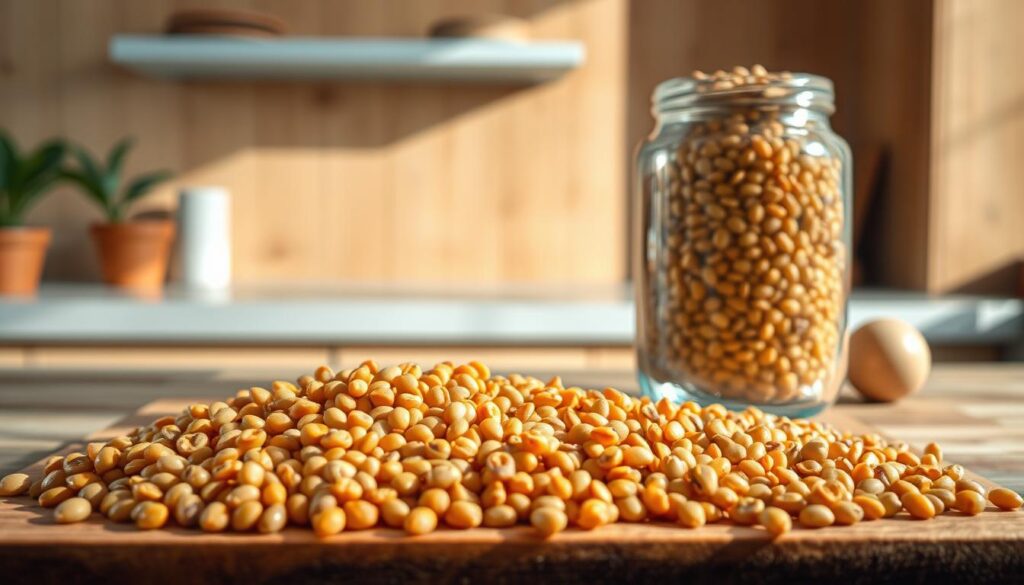
More Than Just Muscle Fuel
As a chef and mom, I rely on lentils because they work with my schedule. Their protein isn’t just about quantity—it’s quality. Unlike many plant sources, they contain all nine essential amino acids needed for muscle repair. Pair them with whole grains, and you’ve got a complete protein rivaling chicken breast.
The Fullness Factor
Fiber does double duty here. It slows digestion, preventing blood sugar spikes, while feeding gut bacteria for better digestion.
“Lentils’ soluble fiber forms a gel-like substance in the gut,”
explains nutritionist Dr. Lena Torres.“This keeps you fuller longer than simple carbs.”
- Iron content supports oxygen flow during workouts
- Magnesium eases muscle tension after long days
- Folate aids cell regeneration—key for active lifestyles
Compared to quinoa or chickpeas, lentils cook faster and absorb flavors beautifully. Use half-cup portions in salads or bulk up soups without heavy calories. They’re proof that smart nutrition doesn’t require complicated recipes—just smart choices.
Diverse Lentil Varieties: Red, Brown, Green, and More
Ever wondered why some recipes turn mushy while others hold perfect bite? The answer lies in your lentil selection. Like choosing the right flour for baking, picking the ideal variety ensures your dish shines. Let’s break down the rockstars of the legume world.
Texture & Timing: Your Recipe’s Secret Sauce
Red varieties dissolve into silky thickness—perfect for Indian dals or creamy soups. Green and brown types keep their structure, making them ideal for salads or stuffed peppers. “I always keep three types in my pantry,” says Chef Callie. “It’s like having different pasta shapes—each serves a unique purpose.”
| Type | Texture | Cooking Time | Best Uses |
|---|---|---|---|
| Red | Creamy | 15-20 mins | Curries, soups |
| Green | Firm | 25-30 mins | Salads, casseroles |
| Brown | Chewy | 20-25 mins | Stews, tacos |
Need a quick weeknight meal? Reach for red. Their fast cook time means dinner’s ready when you are. For meal prep, brown lentils hold up best—toss them in dressings without turning soggy.
Here’s my golden rule: measure dry lentils by the cup before cooking. One cup expands to 2.5 cups cooked—enough for four servings. Swapping varieties? Adjust liquid amounts. Red types need ½ cup less broth than brown to avoid soupy results.
“Think of lentils as your recipe’s backbone. Choose wisely, and your flavors will sing.”
Global Inspirations: Mediterranean, Moroccan, and Beyond
Your spice cabinet holds endless possibilities for transforming simple legumes into global comfort food. Let’s explore how regional flavor combinations can turn basic ingredients into meals that feel like culinary postcards.

Flavor Profiles from Different Cultures
Moroccan harira taught me the magic of cinnamon and ginger in savory dishes. Simmer tomatoes with earthy cumin and a pinch of saffron, and suddenly you’re dining in Marrakech. For Mediterranean flair, toss cooked legumes with lemon, oregano, and roasted red peppers—then stuff them into pitas with cool cucumber yogurt sauce.
Using Regional Spices Like Cumin and Harissa
Harissa paste became my weeknight hero after discovering its smoky depth. A teaspoon elevates basic tomato-based stews, while ground cumin adds warmth to Mexican-inspired bowls. My family’s favorite? A 20-minute creamy sauce blending tahini, lemon, and smoked paprika—perfect for drizzling over spiced legumes.
- North African: Cumin + coriander + preserved lemon
- Greek: Oregano + garlic + Kalamata olives
- Indian: Turmeric + garam masala + fresh cilantro
Don’t fear the spice rack—start with one new flavor weekly. Swap basil for mint in your next salad, or add smoked paprika to roasted veggies. These small shifts keep meal prep exciting without demanding extra time.
Quick and Easy Lentil Meal Prep Strategies
Mastering your weekly meals starts with smart systems, not more hours. Batch cooking turns chaotic evenings into streamlined experiences—imagine opening your fridge to ready-to-heat dishes bursting with global flavors. Let’s build your blueprint for efficiency.
Batch Cooking for the Busy Week
Sunday afternoons became my kitchen reset time after realizing how 90 focused minutes could save 5+ hours later. Cook triple portions of versatile bases like spiced legumes or roasted veggies. Store them in stackable containers labeled with dates—your future self will thank you.
| Prep Stage | Time Saved | Best Storage |
|---|---|---|
| Chopped aromatics | 15 mins/day | Glass jars (fridge) |
| Cooked bases | 30 mins/meal | Freezer bags |
| Portioned sauces | 10 mins/dish | Ice cube trays |
Avoid soggy textures by cooling components separately before combining. For grain bowls, layer dressings at the bottom with hearty ingredients on top. Reheat frozen meals in 3-minute intervals, stirring between to maintain texture.
My golden rule? Prep what excites you. Love Thai curry? Simmer a big batch with coconut milk and freeze in muffin tins for single servings. Craving Mediterranean flavors? Marinate cooked legumes with lemon and herbs—they’ll absorb flavors while chilling.
“Batch cooking isn’t about perfection—it’s about creating options that make nourishing choices effortless.”
Step-by-Step Preparation: Achieving Tender & Flavorful Lentils
Ever stared at a pot of legumes wondering why they’re mushy one day and undercooked the next? The secret lies in treating them like pasta—timing and technique matter more than you’d think. Let’s walk through my foolproof method developed through years of test batches and happy accidents.
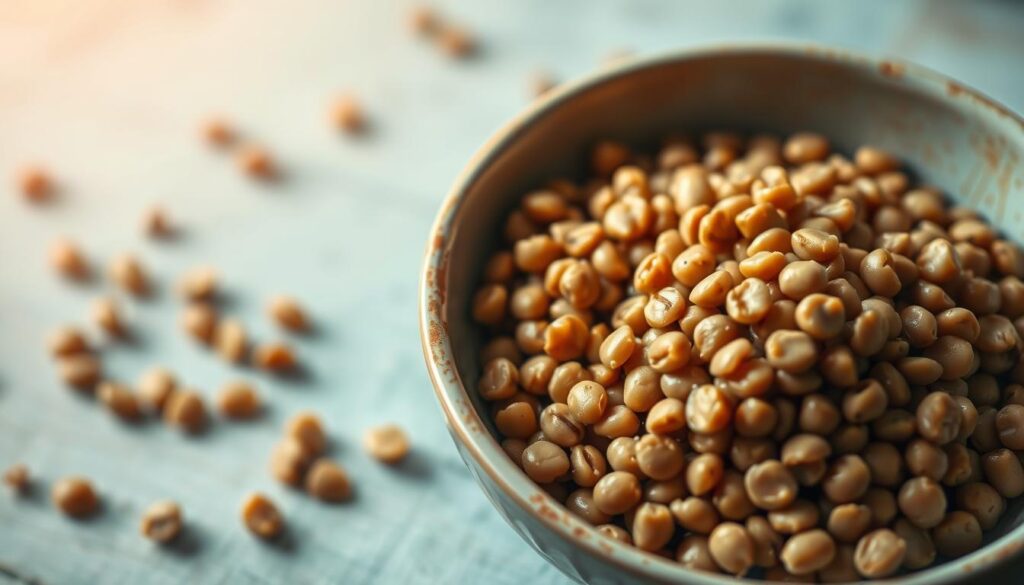
Techniques for Perfectly Cooked Legumes
Start with the right foundation. For every 1 cup of dried legumes, use 3 cups of water or broth. Bring to a boil, then reduce to a gentle simmer—like a spa day for your ingredients. Here’s my go-to process:
- Rinse thoroughly (yes, even pre-washed varieties)
- Combine with liquid in a heavy-bottomed pot
- Simmer uncovered, stirring only twice
- Test texture at the 15-minute mark
Pro tip: Salt after cooking. Adding it too early can toughen the outer layer. For salads, aim for al dente—they should hold their shape when tossed. Soups benefit from softer textures that blend into broths.
Mastering Texture Like a Pro
Different dishes demand different finishes. Use this quick reference guide:
| Use Case | Cook Time | Water Ratio |
|---|---|---|
| Salad Toppers | 12-18 mins | 1:2.5 |
| Soup Bases | 20-25 mins | 1:3 |
If your legumes turn too soft, don’t panic. Blend them into dips or thicken sauces. Undercooked? Add ¼ cup warm water and simmer 5 more minutes. The key is frequent tasting—trust your tongue over strict timers.
Remember: They continue cooking as they cool. Spread them on a baking sheet to stop the process if using later. With these tricks, you’ll nail the texture every time, whether crafting grain bowls or freezer-friendly stews.
Satisfying Lentil Soups and Stews for Busy Weeknights
When the clock strikes six and hunger looms, nothing beats a steaming bowl of comfort. My family’s weeknight survival strategy? Building depth of flavor through layered spices and forgiving cooking methods. Let’s turn your pressure cooker or Dutch oven into a flavor incubator.
Hearty Recipes with Vegetables and Spices
Last Tuesday’s Instant Pot creation became an instant classic: smoky paprika, diced tomatoes, and carrots simmered with vegetable broth. Twenty minutes later, we ladled it over crusty bread—zero chopping marathons required. The secret? Frozen mirepoix mix.
For stews, I brown mushrooms first to mimic meaty richness. A splash of balsamic vinegar adds brightness to earthy combinations. Try this formula:
- Sauté aromatics (onion, garlic, celery)
- Add spices (cumin + smoked paprika)
- Pour broth and legumes
- Simmer until velvety
Adjusting Textures with Instant Pot or Stovetop Methods
Pressure cookers excel at melding flavors quickly but require less liquid. Stovetop versions let you adjust thickness as you go. Use this cheat sheet:
| Method | Liquid Ratio | Texture |
|---|---|---|
| Instant Pot | 1:2.5 (legumes:broth) | Consistent tenderness |
| Stovetop | 1:3 | Customizable firmness |
Freeze portions in wide-mouth jars—leave 1-inch space for expansion. Thaw overnight, then reheat with a splash of water to revive textures. Your future self will savor the foresight.
Hearty Lentil Salads and Power Bowls for Protein Boosts
Tired of salads that leave you hungry by 3 PM? Let’s build vibrant bowls that crunch, zing, and satisfy. My Greek-inspired creation—packed with chickpeas, crisp veggies, and lemon dressing—became a lunchbox staple after my kids devoured it three days straight.
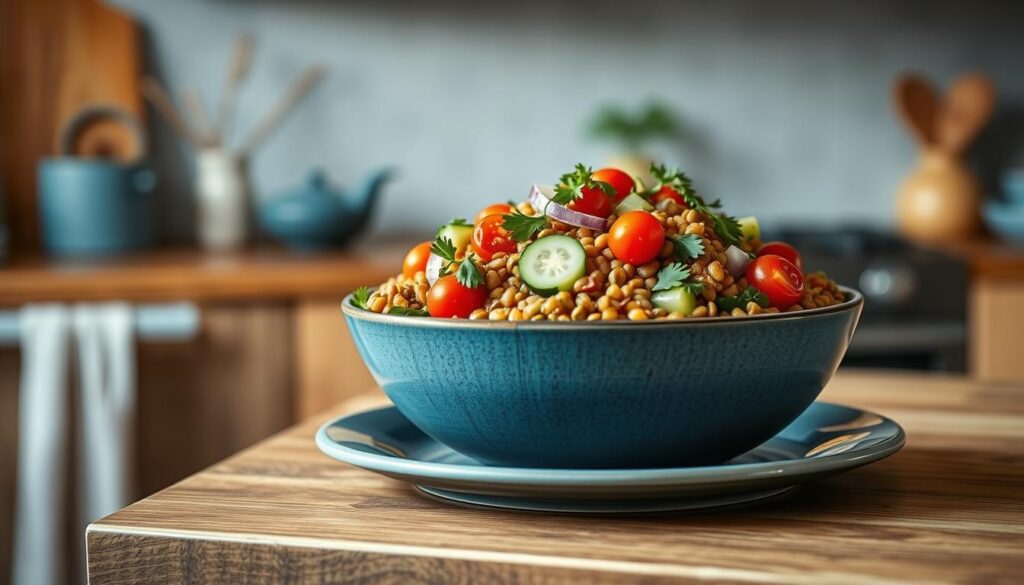
Combining Textures That Sing
Start with 1 cup cooked legumes as your base—their earthy flavor anchors brighter ingredients. Toss in diced cucumbers, roasted red peppers, and chickpeas for contrasting crunch. “Texture is everything here,” I remind my cooking class. “Soft, chewy, and crisp elements keep every bite exciting.”
Dressings That Elevate Simple Ingredients
Whisk together lemon juice, olive oil, and garlic for a bright sauce that clings to every ingredient. Crumble feta over the top—its saltiness balances the tang. Fresh dill or mint adds aromatic freshness that survives fridge storage.
| Base | Veggies | Protein Boost | Dressing |
|---|---|---|---|
| Cooked green | Cherry tomatoes + spinach | Chickpeas | Lemon tahini |
| Mixed greens | Shredded carrots + radishes | Hard-boiled egg | Yogurt dill |
| Quinoa blend | Roasted zucchini + peppers | Grilled chicken | Balsamic glaze |
Assemble bowls in mason jars for grab-and-go ease: dressings at the bottom, sturdy veggies next, greens on top. They’ll stay crisp for three days—just shake before eating. These combos work equally well for dinner when paired with crusty bread.
Creative Twists: Lentils in Tacos, Burgers & More
Who says taco night needs meat? These tiny legumes transform into crave-worthy fillings that even picky eaters devour. My Tuesday tradition began when my kids didn’t notice the swap—now we rotate between smoky “chorizo” bowls and crispy patties loaded with avocado crema.
Transforming Legumes into Flavorful Taco Meat
Start with cooked brown varieties—their chewy texture mimics ground beef beautifully. Heat olive oil in a skillet, then add:
- 1 cup legumes
- 1 tbsp chili powder
- 1 tsp smoked paprika
- ½ tsp garlic granules
Sizzle until fragrant, about 3 minutes. Crumble with a spatula for that rustic, meat-like finish. Serve in warm tortillas with pickled onions and lime crema.
| Filling Type | Key Ingredients | Prep Time |
|---|---|---|
| Traditional Beef | Ground meat, taco seasoning | 20 mins |
| Legume Blend | Cooked legumes, smoked spices | 12 mins |
Freeze seasoned mixtures in muffin tins for single servings. Reheat straight from frozen—perfect for rushed evenings. “The texture surprised me,” admits my neighbor Jen. “It’s heartier than store-bought substitutes.”
Boost flavor with toasted cumin or chipotle powder. Top burgers with melted pepper jack or stuff pitas with crunchy slaw. These twists keep meals exciting while delivering 14g protein per serving—no compromise on taste.
High Protein Lunch Prep Lentils: Recipes and Variations
Your kitchen counter could become a global tasting menu this week—no plane ticket required. From smoky Ethiopian stews to zesty Italian salads, these dishes prove humble ingredients can shine when paired with bold techniques. Here’s how to explore world flavors without overhauling your routine.
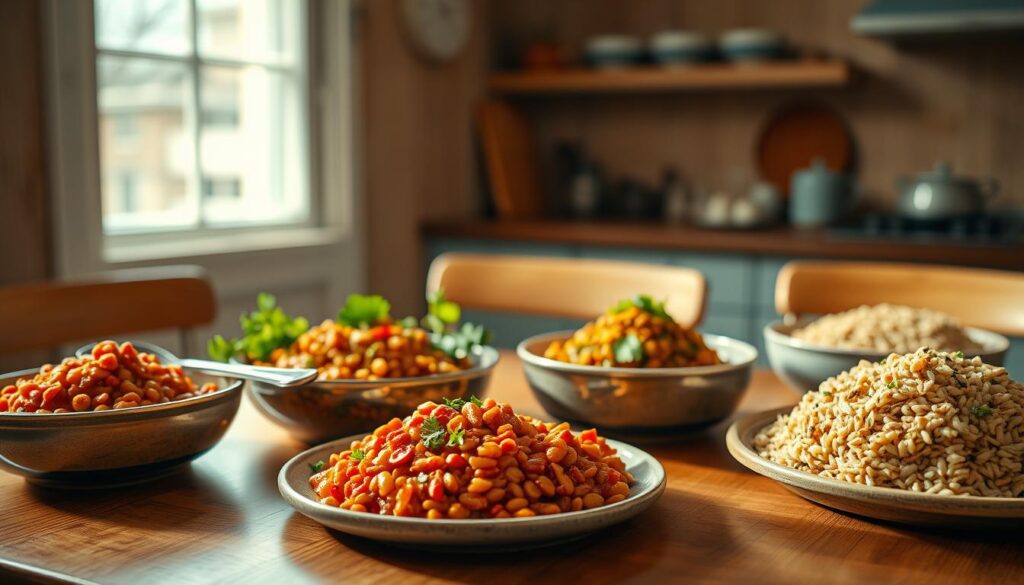
Signature Dishes from Global Kitchens
My daughter still begs for the Berbere-spiced stew we discovered last winter—a hearty blend of tomatoes, carrots, and warming spices inspired by Ethiopian cuisine. For busy nights, I lean on a 30-minute vegan shepherd’s pie loaded with mushrooms and thyme. Both freeze beautifully and deliver 15+ grams of plant-based protein per serving.
Tested favorites from my recipe collection:
- Kale & Coconut Curry: Thai-inspired with lemongrass and lime (ready in 25 minutes)
- Spanish Lentil Escabeche: Marinated with roasted peppers and sherry vinegar (perfect for jar salads)
- Tex-Mex Taco Filling: Smoked paprika and chipotle blend for wraps or nachos
Adjust heat levels by swapping jalapeños for bell peppers, or boost umami with sun-dried tomatoes. “The magic lies in balancing spices with pantry staples,” notes Chef Marco, who shared his grandmother’s Sicilian soup method. Each dish includes at least two veggies and whole grains for sustained energy.
| Recipe | Key Ingredients | Prep Time |
|---|---|---|
| Moroccan Harira | Cinnamon, chickpeas, celery | 40 mins |
| Korean Bibimbap Bowl | Gochujang, spinach, sesame | 35 mins |
These meals earned rave reviews from meal prep newcomers and seasoned cooks alike. One reader transformed the Korean bowl into a wrap by adding scrambled eggs—proof that recipes evolve with your taste. Start with one new dish weekly, and soon your freezer will overflow with global comfort food.
Global Flavors in Sauces & Spices for Lentils
A well-crafted sauce can turn basic ingredients into a culinary journey. My kitchen mantra? “Sauces are the bridge between simple and spectacular.” Whether you’re simmering tomatoes with garlic or whisking coconut milk into golden curry, these liquid heroes unlock endless possibilities.
Building Flavor Foundations
Start with three core elements: acid, fat, and aromatics. A tangy tomato base gains depth when sautéed with onions and olive oil. For Thai-inspired dishes, coconut milk mellows fiery chilies while carrying turmeric’s earthy notes. “Balance bold spices with subtle sweetness,” advises Chef Priya from Curious Cuisiniere.
| Sauce Type | Key Ingredients | Best Pairing |
|---|---|---|
| Smoky Tomato | Paprika + roasted garlic | Mediterranean salads |
| Coconut Curry | Ginger + lemongrass | Steamed rice bowls |
| Lemon Herb | Dill + Greek yogurt | Cold grain salads |
Herb & Spice Layering Techniques
Fresh herbs add brightness just before serving. Toss chopped cilantro into Mexican-inspired bowls or stir basil into Italian marinara. For spice blends:
- Toast cumin seeds to intensify their nutty flavor
- Mix harissa with honey for sweet-heat glazes
- Blend smoked paprika into tomato sauces
Freeze leftover sauces in ice cube trays—drop one into reheated legumes for instant flavor revival. As my friend Marcos says, “A good sauce makes Monday meals taste like Friday feasts.”
Meal Prep Tips: How to Cook and Store Lentils
Your future self will thank you for spending 20 minutes now to save hours later. Proper storage transforms cooked legumes into versatile building blocks for soups, salads, and grain bowls—all while preserving their texture and nutrients.
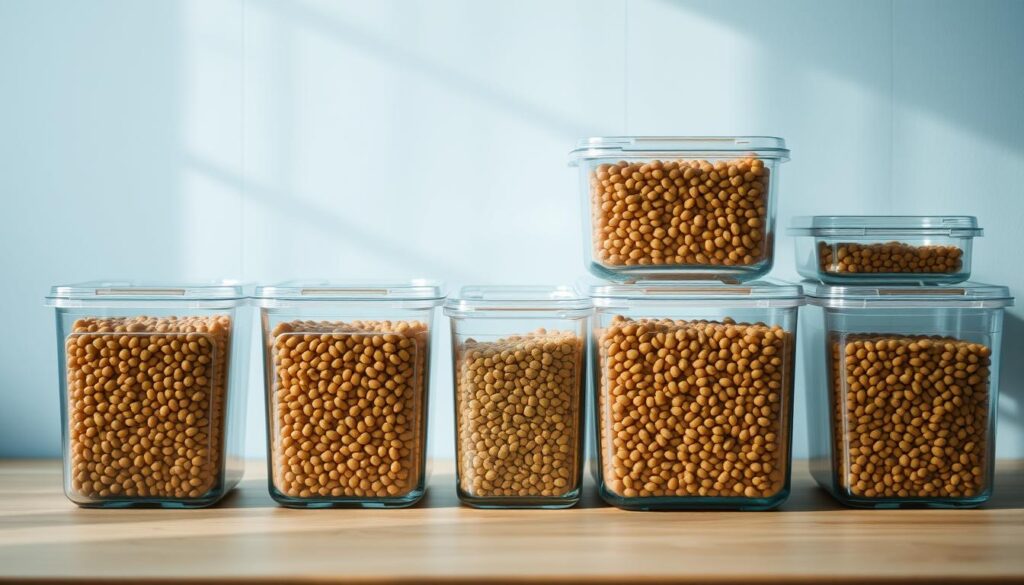
Best Practices for Freezing and Reheating
Start by cooking a big batch. Use a heavy-bottomed pot with 3 cups water per 1 cup dried legumes—simmer until tender but not mushy. Spread them on a baking sheet to cool completely before portioning. This stops overcooking and prevents clumping.
Freeze in flat layers using silicone molds or freezer bags. Squeeze out air to avoid freezer burn. Label with dates—they’ll stay fresh for 3 months. For single servings, try muffin tins. Once frozen, transfer to containers.
| Dish Type | Reheating Method | Pro Tip |
|---|---|---|
| Soup/Stew | Stovetop + splash of broth | Stir frequently on medium-low |
| Salad | Thaw overnight in fridge | Toss with fresh herbs before serving |
| Grain Bowl | Microwave in 1-minute intervals | Cover with damp paper towel |
Revive textures by adding moisture during reheating. A drizzle of olive oil or lemon juice refreshes flavors. “I freeze sauces separately in ice cube trays,” shares meal prep enthusiast Gina. “Toss one into the pan while warming—instant flavor boost.”
Remember: Well-stored legumes become your secret weapon. They’ll turn rushed evenings into 10-minute meals without compromising quality.
Pairing Lentils With Vegetables and Whole Grains
Ever face the “what’s missing?” feeling when assembling meals? The answer often lies in balancing textures and nutrients. Combining legumes with colorful veggies and hearty grains creates plates that satisfy both taste buds and energy needs. Think roasted sweet potatoes adding sweetness to earthy flavors or wild rice contributing a nutty crunch.
Complementary Ingredients for a Balanced Plate
Start with a 1:1:1 ratio—one cup cooked legumes, one cup veggies, and half a cup whole grains. This framework ensures variety without overcomplicating portions. For example:
- Sauteed spinach + garlicky mushrooms + brown rice
- Roasted cauliflower + cherry tomatoes + quinoa
- Steamed kale + caramelized onions + barley
Starchy vegetables like Yukon golds or butternut squash add creaminess, while leafy greens provide freshness. “Pairing iron-rich legumes with vitamin C-packed veggies boosts absorption,” notes dietitian Mara Lee. Try tossing roasted red peppers into a rice bowl or mixing shredded carrots into grain salads.
| Base | Vegetable | Grain | Flavor Boost |
|---|---|---|---|
| Cooked green | Zucchini | Farro | Lemon zest |
| Red | Sweet potato | Couscous | Smoked paprika |
Scale recipes effortlessly: double the cup measurements for family dinners or halve them for solo lunches. Leftover roasted veggies? Fold them into next-day grain bowls with a drizzle of tahini. These combos work for any meal—swap quinoa for couscous in Moroccan-inspired dinners or use wild rice in Tex-Mex stuffed peppers.
Easy and Time-Saving Recipes: 30-Minute Wonders
Rushed evenings don’t have to mean bland meals—discover how global flavors can come together faster than takeout. My family’s go-to Spicy Coconut Curry comes together while my kids finish homework, and the Instant Pot Soup simmers during soccer practice carpool. These dishes prove that smart cooking trumps speed.
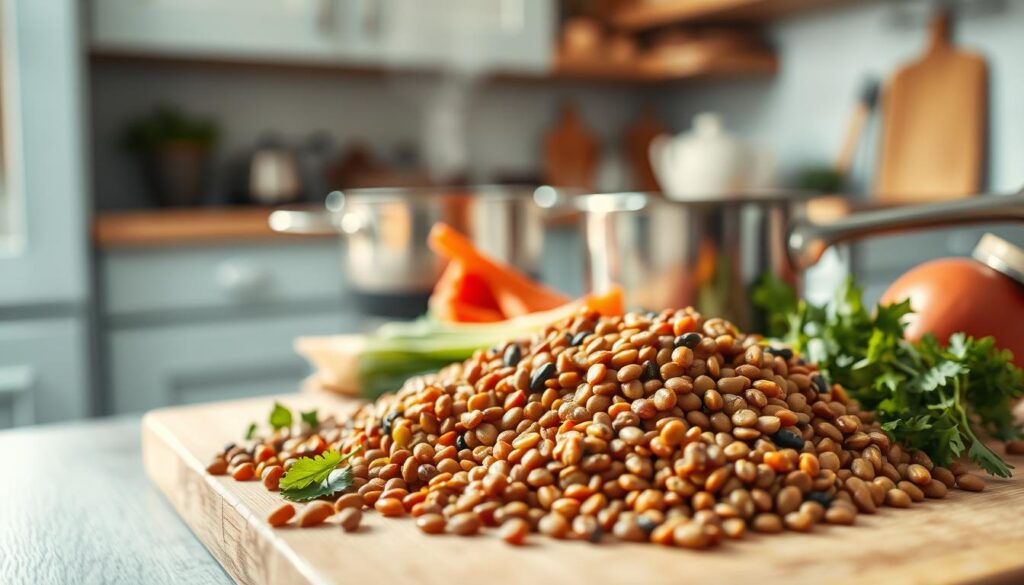
Quick Dinner Ideas Without Sacrificing Flavor
Last Thursday, I whipped up Moroccan-spiced tomato stew while helping with math worksheets. The secret? Pre-chopped mirepoix from the freezer aisle. Try these weeknight heroes:
| Recipe | Key Ingredients | Active Time |
|---|---|---|
| Spicy Coconut Curry | Red curry paste, kale, coconut milk | 22 mins |
| Instant Pot Soup | Carrots, cumin, fire-roasted tomatoes | 17 mins |
Batch-cook bases on Sundays. Freeze portions in muffin tins for single servings. Reheat with a splash of broth—texture stays perfect.
Step-by-Step Guide for Weeknight Convenience
Set your mise en place before turning on the stove. Here’s my fail-proof system:
- Gather all spices and chopped veggies
- Heat oil while measuring broth
- Simmer sauces while prepping grains
“I keep pre-mixed spice blends in jars,” shares my friend Rosa. “It cuts cooking minutes in half.” Store leftovers in wide-mouth containers—they stack neatly and thaw evenly.
Great meals don’t need hours. With strategic prep and bold flavors, even hectic nights can end with satisfied smiles.
Plant-Based Protein: Balancing Lentils with Other Ingredients
Building meals around plant-powered ingredients doesn’t require complicated formulas—just smart pairings. These tiny nutritional powerhouses shine when combined with vibrant vegetables and hearty grains. Let’s explore how to layer flavors and textures for meals that satisfy both taste buds and energy needs.
Combining Legumes, Vegetables, and Grains
Think of your plate as a trio: 1 part legumes, 1 part veggies, ½ part whole grains. This ratio delivers sustained energy without weighing you down. My family’s favorite weeknight bowl mixes cooked lentils with roasted butternut squash and nutty farro—topped with toasted pumpkin seeds for crunch.
| Legume | Vegetable | Grain | Flavor Boost |
|---|---|---|---|
| Cooked green | Roasted squash | Farro | Sage + lemon |
| Red | Sautéed spinach | Quinoa | Garlic + chili flakes |
Creating Nutrient-Dense, Filling Dishes
Fiber-rich combinations keep hunger at bay longer than simple carb-heavy meals. Try folding shredded kale into warm lentil mixtures—the heat softens the greens while preserving nutrients. “The key is contrasting textures,” notes dietitian Clara Mendez. “Crunchy veggies balance creamy legumes beautifully.”
- Add roasted cauliflower for meaty chew
- Mix in chickpeas for extra protein
- Toss with citrus zest to brighten earthy flavors
These dishes work for everyone—from vegetarians to flexitarians. Last week’s meal prep star? A smoky paprika-spiced recipe with black beans and wild rice that even my meat-loving neighbor requested. Simple food, done right, becomes crave-worthy fuel.
Conclusion
Your journey to flavorful, nourishing meals starts with a single pot and a dash of curiosity. These versatile legumes prove that wholesome eating—packed with plant-based protein and fiber—doesn’t require fancy techniques. Whether simmering a Moroccan-inspired stew or tossing a zesty salad, every dish becomes an opportunity to fuel your day while exploring global flavors.
The strategies we’ve shared thrive in real kitchens. Busy parents rave about freezer-friendly meals and bold spice blends transforming their routines. One reader reinvented the coconut curry recipe by swapping kale for spinach—proof that these bases invite creativity.
What matters most isn’t perfection, but progress. Start with one new recipe this week using pantry staples. Share your creations with our community—every tip strengthens our kitchen wisdom.
Remember, nourishing your body and delighting your taste buds can happen in the same pot. Ready to stir the possibilities?

